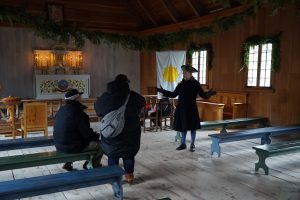 If you attend the Colonial Christmas event at Colonial Michilimackinac, you will experience part of how Christmas was celebrated at the Mission of St. Ignace at Michilimackinac in 1679. An earlier Jesuit Christmas celebration resulted in the first North American Christmas carol, the Huron Carol.
If you attend the Colonial Christmas event at Colonial Michilimackinac, you will experience part of how Christmas was celebrated at the Mission of St. Ignace at Michilimackinac in 1679. An earlier Jesuit Christmas celebration resulted in the first North American Christmas carol, the Huron Carol.
Father Jean de Brebéuf, born in France in 1593, began his missionary work in New France in 1625. A member of the Society of Jesus, the Jesuits, he worked mostly among the Wendat, also known as the Huron, near Georgian Bay. He became fluent in their language and, among other linguistic work, translated the catechism into Wendat. In about 1642 Brebéuf wrote “Jesous Ahatonhia” (Jesus, he is born) in Wendat as a Christmas carol for the Wendat he lived among and hoped to convert. It fits the traditional French folk tune “Une Jeune Pucelle.”
Father Brebéuf was executed by the Haudenosaunee, also known as the Iroquois, in 1649, but “Jesous Ahatonhia” lived on among the Wendat. It was documented by Jesuit Father Etienne Thomas de Villeneuve Girault at Lorette, Quebec, between 1747 and 1794. It was translated into French by Paul Tsawenhohi (aka Picard), a Wendat notary at Quebec City. It was translated into English in the early twentieth century. “Twas in the Moon of Wintertime,” the most widely known version in the United States, was written by Jesse Edgar Middleton in 1926. It is not a direct translation, but a romanticized version, lumping stereotypes of many Native American cultures together.
To hear “Jesous Ahatonhia” in the original Wendat, French, and a more accurate English translation, as well as to see it in American Sign Language click here or watch below:









